Direct/Handmade Sound programme
co-curated by the Centre for Visual Music and Bath Spa University Centre for Musical Research.
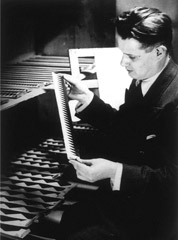 Rudolf Pfenninger – Barcarole. 1932, digital (originally 35mm), 8 min
Rudolf Pfenninger – Barcarole. 1932, digital (originally 35mm), 8 min
..there is an ur-legend surrounding the origin of what Pfenninger called his tönende Handschrift (Sounding Handwriting)… Pfenninger seems to have been motivated less by synesthesial speculations than by economic necessity. According to the story, the poorly paid inventor Pfenninger was eager to provide a sound track for the experimental animations he was making on the side, but he could afford neither the musicians nor the studio to record them. Instead, he sat down with an oscilloscope and studied the visual patterns produced by specific sounds until he was able – sometime in late 1929 or early 1930s – to isolate a unique graphic signature for each tone. Using the newly available optical film soundtrack to test his experimental results, he would painstakingly draw the desired curve onto a strip of paper which he then photographed in order to integrate it into the optical sound track. The resulting sound, phenomenalized by the selenium cell, was one that had never been previously recorded but was, in effect, written by hand: “hand-drawn sound,” as Pfenninger called it. (from Thomas Y. Levin – “Tones from out of Nowhere”: Rudolph Pfenninger and the Archaeology of Synthetic Sound)
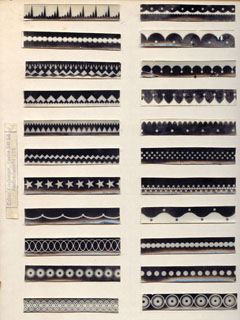 Oskar Fischinger – Ornament Sound. 1932, 16mm (originally 35mm), 5 min
Oskar Fischinger – Ornament Sound. 1932, 16mm (originally 35mm), 5 min
Between ornament and music persist direct connections, which means that Ornaments are Music. If you look at a strip of film from my experiments with synthetic sound, you will see along one edge a thin stripe of jagged ornamental patterns. These ornaments are drawn music — they are sound: when run through a projector, these graphic sounds broadcast tones or a hitherto unheard of purity, and thus, quite obviously, fantastic possibilities open up for the composition of music in the future. – OF (image (c) Elfriede Fischinger Trust).
Biography
A full biography of Oskar Fischinger can be found on the Center for Visual Music site: http://www.centerforvisualmusic.org/Fischinger/OFBio.htm
Barry Spinello – Soundtrack. 1969, 16mm, 10 min
Black and white with some color hand-applied to each print, hand-painted image, hand-painted sound.
I think every student of film should, early in his studies, make a film such as Soundtrack; namely, a film in which sound and image are conceived together as a unit and painted one frame at a time. The advantages for students of handpainting sound and image are threefold: 1. the expense involved is minimal. 2. there is no time lag between the conception of an idea and its realization and screening (no lab wait, etc.) 3. ideas can be expanded, modified and changed immediately and directly after viewing. A basic feel for audio-visual space-timing and the grammar of the frame can be learned in this way. … BS
Articles and illustrations which describe the tools and techniques used in making Soundtrack can be found in Source magazine (issue no.7).
Barry Spinello – Six Loop Paintings. 1970, 16mm, 11 min
In Six Loop Paintings, as in Soundtrack, sound and image are hand applied directly on to 16mm clear leader. The image at a given instant is repeated both on the image track and soundtrack, so that the viewer is visualizing the image he is hearing. However, unlike Soundtrack, the images and sounds in Six Loop Paintings are not painted; they are made by cutting to size and pasting acetate self-adhesive patterns (Micotape and Zipatone) directly onto the clear film. Each pattern yields a distinct sound. Patterns of lines yield square wave sounds; patterns of dots yield sine wave sounds; patterns of diamonds yield sawtooth wave sounds, etc. The finer the pattern, the higher pitched the tone. The further spaced the pattern, the deeper the tone …. I especially recommend Six Loop Paintings to those interested in the texture of sound and image, and in the ways sound and image can relate to each other. – BS
Biography
Barry Spinello came to animation from painting, and completed a number of films in the late 1960’s and early 1970’s (Soundtrack, Sonata for Pen, Brush and Ruler, and Six Loop-Paintings) that explored various techniques of painting and drawing images and soundtracks directly onto 16mm film. His films have been shown at the Whitney Museum and at various international film festivals, and he taught animation at the University of California at Berkeley.
 Lis Rhodes – Dresden Dynamo. 1971, colour 16mm, 10 min
Lis Rhodes – Dresden Dynamo. 1971, colour 16mm, 10 min
‘This film is the result of experiments with the application of Letraset and Letratone onto clear film. It is essentially about how graphic images create their own sound by extending into that area of film which is ‘read’ by optical sound equipment. The final print has been achieved through three, separate, consecutive printings from the original material, on a contact printer. Colour was added, with filters, on the final run. The film is not a sequential piece. It does not develop crescendos. It creates the illusion of spatial depth from essentially, flat, graphic, raw material.’ – Tim Bruce
Biography
Studied at the Royal College of Art, London.
Cinema Curator, London Film-maker’s Co-op 1975-76.
Founder member of Circles Women’s Film & Video Distribution 1979
Member of Four Corners Film Workshop.
Arts Adviser to the Greater London Council 1982-85.
Part-time lecturer at the Slade School of Art, London since 1978.
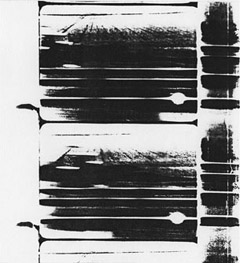 Guy Sherwin – Soundtrack. 1977, 16mm. 8 min
Guy Sherwin – Soundtrack. 1977, 16mm. 8 min
A continuous take through the open window of a train travelling at high speed. The camera points at right angles to the direction of travel and the area framed is from the skyline to the rails immediately below the train. The relative speed of the passing landscape decreases with distance. This is complicated by the fact that at certain speeds (relative to the camera shutter speed) the sleepers appear to move in the contrary direction. Speed also affects the spatial reading of the image, from a three-dimensional space (at a distance) to a two-dimensional one (blurred foreground) comprised of horizontal divisions of the screen area.
By using a technique that translates the image into optical sound, these horizontal divisions create the synchronised soundtrack to the film. Here distance (perspective) affects pitch, and tonality affects volume. Buildings, objects, trains, passing through the picture area, register simultaneously on the soundtrack. As the train passes through the tunnels the screen goes black and the soundtrack cuts out, signifying to most people a break in filming, which was not the case. – GS
Biography
Studied painting at Chelsea School of Art in the late 1960s. His subsequent film works often use serial forms and live elements, and engage with light and time as fundamental to cinema. Recent works include performances that use multiple projectors and optical sound, and installations made for an exhibition space.
Sherwin taught printing and processing at the London Film-Makers’ Co-op (now LUX) during the mid-70s. His films were included in ‘Film as Film’ Hayward Gallery 1979, ‘Live in Your Head’ Whitechapel Gallery 2000, ‘Shoot Shoot Shoot’ Tate Modern 2002, ‘A Century of Artists’ Film & Video’ Tate Britain 2003/4. He lives in London and teaches at Middlesex University and University of Wolverhampton.
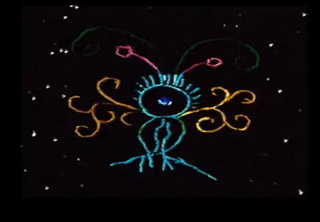 Richard Reeves – Linear Dreams. 1997, digital (from 35mm), 7 min
Richard Reeves – Linear Dreams. 1997, digital (from 35mm), 7 min
Images from the Mind’s eye
Music from the Mind’s ear.
Linear Dreams is an experimental cameraless animated film, As the title suggests the word Linear is composed of two words, line as in drawing, ear; as in hearing. Both sound and picture were drawn directly on to 35mm motion picture film.
Starting with a dot a light that expands into a line into a pulsating circle , a circle of life that explodes into free flowing forts and colour. Stream of conscience abstract reality produced by coloured inks on clear film leader.
Spaces of intermittent imagery separates the scenes. These spaces, to me, represent the forming of ideas, subconscience flickers of thoughts. Created by scratching into black leader, the spaces are sporadic. The size of the shapes correspond to the size, or volume of the sound. Occasional black-outs produce aftervisions which are complimented by echoing sounds. The persistence to vision equals the persistence of sound.
These sounds were created by scratching into the emulsion of blank audio stripes along the edge of 35mm motion picture film. This narrow, but very long stripe is sensitive to fluctutations of light and dark patterns. Rhythms are composed of repeating shapes. Echo was added later to give depth and a persistence of sound or aftersound. – RR
Biography
Richard Reeves is an accompished animator, excelling in the Cameraless technique, where animated images and sound are created by scratching directly onto film.
Richard’s Magnum Opus, “Linear Dreams” (which includes hand-made soundtrack and visuals) took two years to complete. One year for all the sound work, testing, re-dos, editing, and reverb adding. Then all the pictures took another year to create, edit, sync, and finally print.
Richard Reeves served as QAS Production Coordinator from 1994 – 1997.
Richard currently lives and works in British Columbia, Canada.
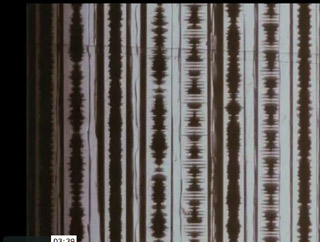 Steve Woloshen – Visual Music for Ten Voices. 2011, digital, 3.5 min
Steve Woloshen – Visual Music for Ten Voices. 2011, digital, 3.5 min
In Barthes’ essay, “The Grain of the Voice”, the concept of the “genosong” was evoked to separate the sound of the voice from its language. Visual Music for Ten Voices distinguishes the physicality of the optical vocal track as having a unique identity from its actual resonance in sound films. Designed as a 10-foot black box projection loop, this film focuses on the rhythm and materiality of ten 35mm optical soundtracks. Each musical passage maintains its original length and linear harmony with the other tracks, collectively creating a new sense of motion and repetition. This is a silent film. – SW
Biography
Montreal born artist, Steven Woloshen (BFA, MFA Studio Arts) has been passionately creating short abstract films and time-based-art installation pieces since 1977. He has been invited to show his work, has lectured on the subject of handmade analogue film techniques and has been commissioned to create unique films for artist – run centers, international film festivals and galleries. In 2010, he published his first book on the subject of decay, archiving and handmade filmmaking techniques, titled “Recipes for Reconstruction: The Cookbook for the Frugal Filmmaker.”
Prints and films courtesy the filmmakers, LUX and Light Cone
Jury Selections 1
 Zai Tang – Window Music. 2009, video, 1:40
Zai Tang – Window Music. 2009, video, 1:40
Window Music (2009) is a short audio-visual piece comprised of sound and video footage captured from a window in North London. It explores the cyclic nature of sound activity within the environment and the role the soundscape plays in our perception of urban space. The work featured in Esplanade – Theatres on the Bay’s TimeZones exhibition.
Biography
The thrust of my recent projects focus on the evolving relationship between sound and space, in both real and imagined environments. Drawing influence from my research in to acoustic ecology, experimental music and synaesthesia, I see my work as a means of engaging the mind’s eye of the audience through the act of listening. Through this I hope to reveal how a greater awareness of sound can enrich our experience of place and contribute to more dynamic states of being.
I apply a multidisciplinary approach to art making, adapting to whatever means best suits my ideas; whether experimenting with turntable and vinyl records in a live setting, creating immersive site-specific installations or composing sound and music for film. I studied BA Creative Music Technology at Bath Spa University, and completed my post-graduate in Digital Arts at Camberwell College of Arts. Since 2006 I have been exhibiting work and performing in Singapore, London and most notably Venice; collaborating with Tang Da Wu in developing a multimedia sculptural installation at the Singapore Pavilion for the 52nd Venice Biennale (2007).
 Tim Howle/Nick Cope – Son et Lumiere. 2006, video, 7:34
Tim Howle/Nick Cope – Son et Lumiere. 2006, video, 7:34
16mm single frame animation, in camera double exposure, video post-production effects (Sony digital vision mixer) and Final Cut Pro non-linear digital editing software.
Following and mirroring the first collaboration ‘ Open Circuits, in which the music was composed to an existing video edit, Son et Lumières sees work flow in the opposite direction. The visuals are edited to an already existing soundtrack (An edit from a piece called Subplot composed in 2000.) The aim is to follow approaches within video production and post-production which would be analogous to electroacoustic composition methods, techniques and criteria. Working with a 40 second sequence originally shot on 16mm film and double exposed at the time of filming, this material was used as the sole source material from which to work the final 6’44” piece. Through treating, effecting, manipulating and slowing down the image and running the footage through many different processes and post -production technologies, the material nature of the footage and techniques of digital post-production processes are explored. Gesture, timbre and movement in sound are examined and equivalent or supplementary gestures of image, movement and transition are investigated which may mimic or counterpoint the accompanying sound elements and compositional methods.
Biographies
Tim Howle:
Currently is based at Kent University where he lecturers in composition. Previous posts include: University of Hull and Oxford Brookes University. His work centres on electroacoustic music including pieces for tape, performer and live electronics and pieces involving visual media. His work has been performed throughout the US, the EU and Asia.
Nick Cope:
Currently works as Senior Lecturer in Video and New Media Production at the University of Sunderland. Graduated in 1986 from Sheffield Hallam University and worked freelance in film and video production with a particular emphasis on music and moving image work, collaborating with Cabaret Voltaire, the Butthole Surfers, O yuki Conjugate and Electribe 101 amongst others. More recent work has included projection work for public arts projects and installation collaborations.
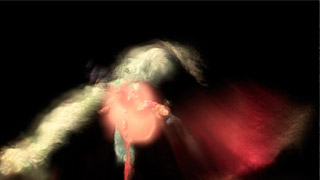 Jean Piche – Australes. 2010, video, 9:15
Jean Piche – Australes. 2010, video, 9:15
Australes is the second component of a triple-screen videomusic installation named Hémisphères. The three parts of the installation explore a method for controlling a graphic particle generator with an underlying real video which is not seen. In the case of AUSTRALES, the underlying image is ten minute unedited shot of a children’s parade in Cusco, Peru. Colors, forms and movements of the film are coded into control streams for the millions of particles that form the final generated image. Distanciation and metaphor are the ultimate formal aims of the Hémisphères series and synchresis is rarely used as a discursive device. Music and image search for and hopefully achieve perceptual unity at a non-parametric level. The music for AUSTRALES is largely composed with the author’s audio software and stages obscured interviews with the late singer Michael Jackson and 80’s model Gia Carangi.
Australes is originally made for 3-channel video – the version presented here is for single channel video.
Biography
Jean Piché (1951) is a composer, video artist and software designer who has been active in computer music since the beginnings of the field in the 1970s. While his personal practice is now devoted to videomusic, a hybrid meshing music and moving images, he has produced works in every genre of electroacoustics. His work aims for poetic expression beyond any avowed formalism. As a music software designer he is the creator of novel applications, amongst them Cecilia, a popular front end to Csound. He authored and designed the TamTam music software suite running on the « One Laptop per Child » XO computer. He teaches composition and video at the Université de Montréal.
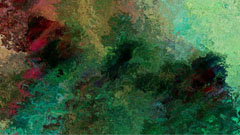 Jean Detheux – Machinalement (v.31). 2010, video, 6:00
Jean Detheux – Machinalement (v.31). 2010, video, 6:00
Images created from/for a phenomenal flute improvisation by Jean Derome. The film attempts to make visible what the director sees when “listening with his ears.” The focus is on that sensitive and elusive space that can exist between the music and the images, not trying at all to mirror the music, but not ignoring it either.
Biography
Belgian-born, Jean Detheux is a graduate of the Académie Royale des Beaux-Arts de Liège.
Art teaching in Canada and the U.S since 1971.
Exhibited works in Europe, the Middle-East and the Americas (private and public venues).
Numerous lectures on “The Phenomenology of Vision and the Process of Creation,” “Animating in a different key,” (in French and English).
Masterclasses, articles (French/English, published by AWN, Sage Publications), etc.
Sudden allergies to painting materials forced him to give up painting for digital technology (1997). which brought him to “time-art.”
His films are appearing at film, animation, and music festivals around the globe.
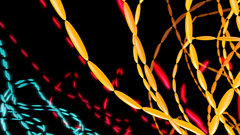 Alison Clifford/Graeme Truslove – Palimpsest. 2011. video, 3:44
Alison Clifford/Graeme Truslove – Palimpsest. 2011. video, 3:44
Articulating the Interstitial
“Palimpsest” is an audiovisual work exploring the space between sound and image through collaboration. Two distinct narratives, audio and visual, collide to find alternative paths and perspectives around a virtual light sculpture. The piece reinterprets one of a series of photographic light paintings taken during a drive at night. The photographs were experiments: improvisations with long exposures, motion and gesture. As images in themselves however, the collaborators found them to be engaging both visually and conceptually.
Visually they bring to mind the poetic: the camera has captured ethereal light trails drawn by the motions of passing traffic in mid-air, giving them an almost sculptural quality. They suggest contours, energies, volumes and spaces that are open to further exploration and interpretation. Conceptually, their contradictory nature seems to suggest ideas of the interstitial – the space or place in-between things – or what Duchamp termed the “infrathin”. The light-forms captured in the image, exist in-between the real and the virtual, brought together in a moment by the camera. They occupy the gaps and breaks between events, and find form in the moment between the shutter opening and closing.
It is in the idea of the interstitial that the collaboration is based. How might these forms be reinterpreted and rewritten for another context? And how might audio be used to structure our visual experience of them? “Palimpsest” responds to these questions, extending and reimagining the source image, in an attempt to articulate the interstitial.
“Palimpsest” was commissioned by Brian Stefans and the San Francisco Museum of Modern Art to accompany Stefans’ series on digital literature – “Third Hand Plays”
Biographies
Alison Clifford is a new-media artist based in Glasgow. Her artistic practice is concerned with the process of translation between different forms of visual media, exploring the creative possibilities of what might be lost or gained through such interpretation. Her output includes net-art, interactive works and audiovisual installations. She has exhibited widely in various international new-media festivals and exhibitions, and has received a BAFTA nomination for her work. Her work was recently published as part of the Electronic Literature Collection Volume 2, USA.
More info: http://www.duck-egg.co.uk
Graeme Truslove (PhD) is a composer and performer based in Glasgow, Scotland. His output includes: electroacoustic and instrumental compositions, theatre sound design, audio-visual installations and improvisation (performing on guitar and laptop). His work is largely concerned with conflicts between intuitive performance and the fixed-medium, often exploring how fixed-medium expressive and structural possibilities can be integrated into improvised performance and vice versa. His approach integrates multiple strata of musical time, ranging from macrostructure down to the formation of timbre itself. Truslove’s work has been performed internationally, and has attracted various awards, most recently 1st prize in Métamorphoses 2010, Belgium.
More info: http://www.graemetruslove.org.uk
Jury Selections 2
 Andrew Hill – Perpetual Motion. 2011, video, 9:15
Andrew Hill – Perpetual Motion. 2011, video, 9:15
This work was inspired by and developed exclusively from materials collected from the Paternoster lift in the Attenborough tower in Leicester. The paternoster lift itself is in constant motion, the open compartments slide slowly between floors in a never ending loop, rising and falling, passing constantly in a seamless flow of perpetual motion.
Biography
Andrew Hill (1986) is a composer of electroacoustic audio-visual music living in Leicester. He composes works and is also fascinated by the way that humans understand and appreciate audio-visual music.
Stephen Callear – In Perpetuity: The Linden Trees. 2011, video, 6:20
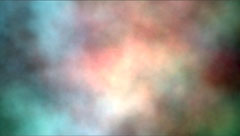 The second in a series of two works, In Perpetuity: The Linden Trees explores the relationship between pitch and noise as metaphor for the transition between life and death. The audiovisual morphology is derived from an implementation of the ‘Audiovisual Particles’ framework, coupling stochastic processes with an external data set to permit the pseudo-concurrent synthesis of audiovisual media.
The second in a series of two works, In Perpetuity: The Linden Trees explores the relationship between pitch and noise as metaphor for the transition between life and death. The audiovisual morphology is derived from an implementation of the ‘Audiovisual Particles’ framework, coupling stochastic processes with an external data set to permit the pseudo-concurrent synthesis of audiovisual media.
Biography
Stephen Callear is currently a doctoral student at Bath Spa University under the supervision of Dr Joseph Hyde. His recently submitted thesis entitled ‘Audiovisual Particles: Parameter Mapping as a framework for audiovisual composition’ investigates the role of cross-modal correspondence within audiovisual composition and presents both a conceptual model and a methodological framework for the creation of abstract audiovisual art.
Maura McDonnell – Silk Chroma. 2010, video, 11:25
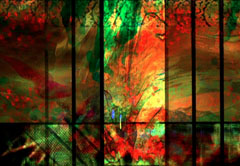 Silk Chroma is a fixed media visual music video that employs a technoscience approach to both colour and timbre experience to create a visual music and electroacoustic composition. Silk Chroma is inspired by the novella “Silk” by Allesandro Baricco. “Silk” was used as a conceptual framework for the creation of the visuals and the music and as the basis for creating a visual drama and electroacoustic composition to conceptually mimic that of silk.
Silk Chroma is a fixed media visual music video that employs a technoscience approach to both colour and timbre experience to create a visual music and electroacoustic composition. Silk Chroma is inspired by the novella “Silk” by Allesandro Baricco. “Silk” was used as a conceptual framework for the creation of the visuals and the music and as the basis for creating a visual drama and electroacoustic composition to conceptually mimic that of silk.
Biography
The work was created as a collaborative effort between teaching staff on the the M.Phil in Music and Media Technologies programme, Trinity College, Dublin. Director and conception was by Dr Dermot Furlong, (course director for the M.Phil in Music and Media Technologies programme, Trinity College, Dublin). Visuals were composed in a visual music approach by Maura McDonnell. Electroacoustic music composition was composed by Dr Linda Buckley. Surround sound design and presentation for installation presentation by Gavin Kearney.
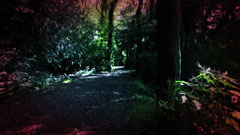 Richard T C Nelmes/Diego Garro – Visitation Adagio. 2011, video, 8:03
Richard T C Nelmes/Diego Garro – Visitation Adagio. 2011, video, 8:03
In this collaborative audiovisual work, landscapes and soundscapes are neighbouring territories for a musical voyage of re-discovery. A quizzical visitor and his arcane, glistening, little companion share with us their chimerical homecoming expedition – encouraging the listener/viewer to contemplate the boundaries and symbiosis of its aural and visual dimensions.
Biographies
Richard T C Nelmes
Having spent five years studying medicine, Richard re-discovered his roots as a musician, gaining a first class honours degree from Keele University, Staffordshire, UK. While there, he developed a passion for audio-visual composition and is due to begin MRes study, at Keele University, under the tutelage of Dr. Diego Garro (his collaborator) and Prof. Rajmil Fischman, in September 2011.
Diego Garro
Senior lecturer in Music Technology, Electroacoustic Music and Video Art at Keele University (UK). His audio and audiovisual compositions have received a number of prestigious international prizes and are regularly selected and performed in various festivals, concerts, events and conferences in UK and abroad. His activity as researcher and educator focuses on working practices and compositional languages that bridge the Electroacoustic idiom with other aspects of popular culture and experimental art (Electronica, glitch, video).
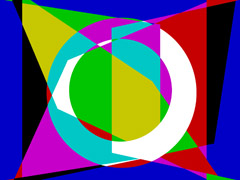 Simon Payne – Vice Versa Et Cetera. 2010, video, 10:00
Simon Payne – Vice Versa Et Cetera. 2010, video, 10:00
Ten variations of four transitions transform the screen from one field of clashing complementary colours to another, via radiating, sweeping and twisting graphic dividing lines. The course of these transitions is interrupted from the offset and becomes increasingly frenetic, especially as the spectrum turns to black and white. Vice Versa Et Cetera is the most recent video in a series of colour field works by Simon Payne, in which six colour plus black and white are paired with ‘test tones’ of varying pitch. Complex interwoven patterns of sound and colour produce optical and aural effects that are difficult to keep up with. In a sense the piece is a work of visual music – colour/form and sound are perfectly synched, and the patterns of the piece are tightly composed – but rather than orchestrating a harmonious relationship between image and sound (vision and hearing) the structure of the video problematises perception: the viewer can’t hope to keep up with the piece.
Biography
Simon Payne (b. 1975) has shown work in numerous festivals and venues including: the Rotterdam International Film Festival, the European Media Arts Festival, Osnabrück; Media City, Windsor, Ontario; the Edinburgh Film Festival; the Serpentine Gallery and Whitechapel Galleries in London; and at Tate Modern for whom he curated a series of programmes entitled ‘Colour Field Films and Videos’ in 2008. He teaches at Anglia Ruskin University, in Cambridge, and lives in London.
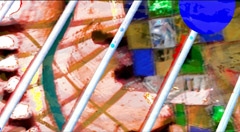 Dave Payling – Theravada Colour Morph. 2009, video, 9:58
Dave Payling – Theravada Colour Morph. 2009, video, 9:58
Theravada Colour Morph is created entirely from images and sounds captured while on location in various parts of Thailand. It reflects the vibrancy of the culture and colours that can be seen there. It also provides a visual and sonic commentary on the indigenous sights and sounds that can be experienced in widely contrasting locations throughout the country. The exclusive use of footage from Thailand imparts a characteristic quality into the composition that is inherited from the source material’s origin. The colour spectrum for example is determined by the enhanced and bold use of certain colours in that country; colour combinations that would not be seen very frequently elsewhere. Greens, purple, yellows and reds are used liberally and dramatically in a culturally defining and ever present way. The original footage is treated in ways that often make it unrecognisable from the source but the end! result still has elements of the Thai culture weaved into its fabric.
Biography
Dave has been a tutor in Music Technologies at Staffordshire University for 10 years. He is also studying part time towards a PhD in Visual Music composition under the guidance of Tim Howle (Medway) and Stella Mills (Staffordshire). His earlier research centred on sonification and his composition ‘Listen (Awakening)’ was performed at the Sydney Opera House as part of the ICAD conference in 2004. His more recent work focuses on composition for Visual (Video) Music with an emphasis on Acousmatic Composition and how this can be interpreted visually with colours. Dave also produces more mainstream Electronic music under the name of ‘PAYL’.
Dave’s more recent compositions have been performed at the Soundings Festival Edinburgh, MANTIS Festival University of Manchester and NoiseFloor Festival Staffordshire.
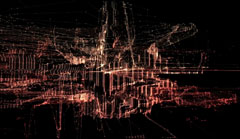 Franz Rosati/Leila Bahlouri – Pathline #1. 2011, video (from live performance), 6:30
Franz Rosati/Leila Bahlouri – Pathline #1. 2011, video (from live performance), 6:30
Pathline #1 is a Visual Music project based on digital noises, soundscape improvisations and generative graphics. The audience’s expectations are mislead by the structure of layered sounds which suddenly move from heavy textural and gestural moments to total silence. The audio part is connected to a visual reactive environment provided with its own behaviour, morphing from smooth and structured configurations to flickering skeletal and chaotic forms. Pathline #1 is about the “aestethic of discontinuity” and investigates the rules beneath the human perception creating an unpredictable evolving aural and visual environment, reminding to complex architectural sketches deformed by a mixture of digital and concrete sounds melted togheter in an extemporary visual music work. Pathline #1 in presented as 2 or 4.1 channels, single, double or triple screen projections.
Biography
Franz Rosati is a sound and media artist, focusing his research on real-time A/V, Visual Music projects and installations following an aesthetic idea based on discontinuity of aural and visual patterns avoiding any kind of repetition through the use of chaos mathematics, generative and stochastic processes. He uses his own custom made software developed in MaxMSP for real-time micro- montage and sound elaboration in the microscopic time scale to realize compositions and performances based on aural and visual matter’s costant metamorphosis.
During the years, Franz Rosati has played in a large number of electroacoustic projects such as Franco Ferguson improvisors collective, MECCANICA FERMA, Solderwire, GRIDSHAPE, developing his own approach to electroacoustic improvisation. In 2007 founded NEPHOGRAM a collective about contemporary audio, visual and installations documents with Stefano Pala a.k.a. UKQWJB.
He also teaches MaxMSP/Jitter for sound design, interactivity and multimedia, focusing in computer vision techniques in several Workshops and Art/Design Institutes, and developed Interactive Examples for Electronic Music and Sound Design, a book about sound theory and practice in MaxMSP.
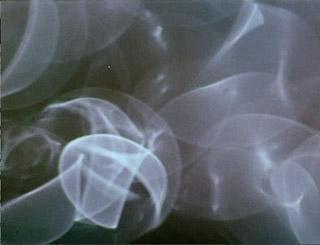
Curated by Bath Spa University Centre for Musical Research
Comingled Containers. 1996, 16mm, 4:00
This “return to photography” (after several years of only painting film) was made on the eve of cancer surgery – a kind of “last testament,” if you will … an envisionment of the fleeting complexity of worldly phenomenon.
Stellar. 1993, 16mm, 2:30
This is a hand-painted film which has been photographically step-printed to achieve various effects of brief fades and fluidity-of-motion, and makes partial use of painted frames in repetition (for “close-up” of textures). The tone of the film is primarily dark blue, and the paint is composed (and rephotographed microscopically) to suggest galactic forms in a space of stars.
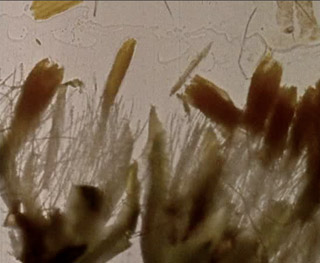
Essence of lepidoptera re-created between two strips of clear mylar tape: an anima animation. What a moth might see from birth to death if black were white and white were black.
“Brakhage made MOTHLIGHT without a camera. He just pasted mothwings and flowers on a clear strip of film and ran it through the printing machine.” – Jonas Mekas “MOTHLIGHT is a paradoxical preservation of pieces of dead moths in the eternal medium of light (which is life and draws the moth to death); so it flutters through its very disintegration. This abstract of flight captures matter’s struggle to assume its proper form; the death of the moth does not cancel its nature, which on the filmstrip asserts itself. MOTHLIGHT is on one level a parable of death and resurrection, but most really concerns the persistence of the essential form, image, and motion of being.” – Ken Kelman
Study in Color and Black and White. 1993, 16mm, 2:30
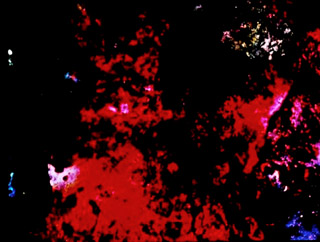
The title is almost the whole of any possible description of this hand-painted and photographically step-printed film, which exhibits variably shaped small areas of color (in a dark field) that explode into full frames of textured color interwoven with white scratch patterns that create a considerable sense of interior depth and three-dimensional movement.
Autumnal. 1993, 16mm, 5:00
This is a film composed of two elements: 1) simple hand-painted frames and brief strips of hand-painting, and 2) strips of blank colors, which appear as overall hues or color tones filtering light itself rather than any pictured scenes. These two elements are interposed in editing so as to suggest the seasonal changes of tree-leaf (from greens to golds, reds and browns) and the sky (from varieties of warm-to-cold blues).

Black Ice. 1994, 16mm, 2:30
I lost sight due a blow on the head from slipping on black ice (leading to eye surgery, eventually); and now (because of artificially thinned blood) most steps I take outdoors all winter are made in frightful awareness of black ice.
These “meditations” have finally produced this hand-painted, step-printed film. – SB
Three Homerics. 1993, 16mm, 6:00
This film is composed of three sections created to accompany a piece of music (by Barbara Feldman) on a Homeric poem: 1) “Diana holds back the night …” is represented by dark shapes suppressing (almost angularly interfering with) orange-golden effusions of paint and the reflective paint-shapes of early morning greens (as if silhouettes or arm and bodily profile were shading the light), 2) Homer’s “… rolling sea …” represented by hand-painted step-printed dissolves of blues in wave shapes, bubbles, and the soft browns and tender greens of seaweed, flotsam-jetsam, and 3) “Ah, love again, the light” represented by painted explosions of multiple hues and lines recurrently interrupted by the “blush” of soft suffusing reds.
Chinese Series. 2003, 16mm, 2:30
Scratching on spit-softened emulsion with bare fingernails, Stan completed this work – all that he could manage of his long dreamed-of “Chinese Series” – in his bed, a couple of months before his death. Printed by Courtney Hoskins, who has written that: “On the negative, it seemed to have the essence of Chinese characters – “strokes” and blocks, etc. In motion, it seems almost like running through a humid bamboo forest . . . green and yellow stalks create these glowing shadows as they cut across the sunlight.
16mm prints courtesy Light Cone, Paris
Biography
Stan Brakhage is one of the most influential filmmakers in American avant-garde cinema, noted for his unflinching social commentaries and technical innovations. Over his nearly 40-year career, he has made over 200 films of varying length. He made his first film, Interim (1952) at age 18 after dropping out of college. Brakhage films seek to change the way we see. They encourage viewers to eschew traditional narrative structure in favor of pure visual perception that is not reliant on naming what is seen; rather his goal is to create a more visceral visual experience, for he believes that a “stream-of visual-consciousness could be nothing less than the pathway of the soul.” To this end, his films are shot in highly sensual colors and utilize minimal soundtracks.
His work can be divided into distinct periods. His first short films explored the properties and possibilities of light. In many of his experimental ventures, Brakhage has forgone traditional cinematography in favor of working directly with the film stock itself. He has occasionally painted, inked, scratched and dyed images onto it; he has also tried pasting organic objects on the film. His most famous example is the 1963 short Mothlight in which he glued moth wings onto the stock. Some of his early films were based on his most intimate experiences that included making love to his new bride–depicted on negative film–in Wedlock House: An Intercourse (1959), and an attempt to bring his dead dog back to life with a camera in Sirius Remembered (1959). During the 1960s, Brakhage’s iconoclastic views were celebrated for their poetry, but during the ’70s, his focus changed to social issues and he alienated many supporters with such disturbing film series as the “Pittsburgh documents” in which he presented many gruesome views of inner city life with films such as Act of Seeing with One’s Own Eyes (1971) which was shot in a morgue. He also continued with autobiographical material with the “Sincerity/Duplicity series. During the 1980s, Brakhage’s focus again changed–this time he became intrigued with creating truly “abstract” films such as Arabics (1982) which consists of brilliant bursts of colored light which he claims, represent “envisioned music.” In addition to filmmaking, Brakhage also wrote books about films and filmmaking and also served as a teacher.
– Sandra Brennan